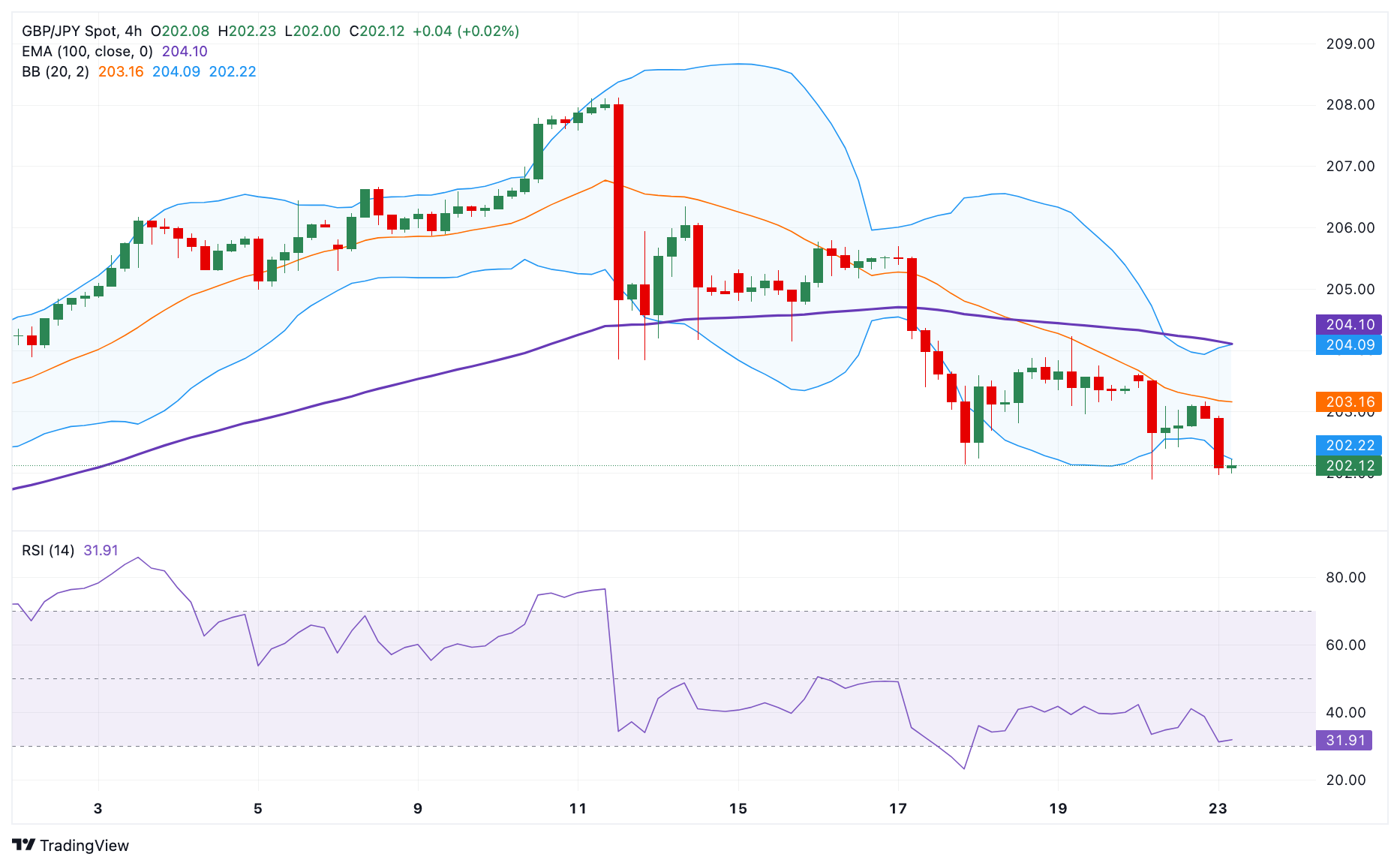GBP/JPY Price Analysis: The crucial support level emerges near 202.00

- GBP/JPY extends decline near 202.20 in Tuesday’s early European session, down 0.45% on the day.
- The cross keeps the negative stance on the 4-hour chart, with the bearish RSI indicator.
- The key support level emerges at the 202.00 psychological mark; the upside barrier is seen at 203.16.
The GBP/JPY cross remains under some selling pressure around 202.20 on Tuesday during the early European session. The risk-averse environment and growing speculation that the Bank of Japan (BoJ) will hike next week support the Japanese Yen (JPY) and create a headwind for GBP/JPY.
Technically, GBP/JPY maintains the bearish outlook unchanged on the 4-hour chart as it holds above the key 100-period Exponential Moving Average (EMA). Additionally, the Relative Strength Index (RSI) stands in bearish territory below the 50-midline, suggesting extended losses cannot be ruled out.
The key support level will emerge at the 202.00 psychological mark. A decisive break below this level will pave the way to 201.14, a low of June 24. Further south, the next contention level is located at 200.48, a low of June 21.
On the upside, the immediate resistance level for the cross is seen at 203.16, a high of July 22. The crucial upside barrier to watch is the 204.00-204.10 region, representing the conference of the psychological level, 100-period EMA, and the upper boundary of the Bollinger Band.
GBP/JPY 4-hour chart
Japanese Yen FAQs
The Japanese Yen (JPY) is one of the world’s most traded currencies. Its value is broadly determined by the performance of the Japanese economy, but more specifically by the Bank of Japan’s policy, the differential between Japanese and US bond yields, or risk sentiment among traders, among other factors.
One of the Bank of Japan’s mandates is currency control, so its moves are key for the Yen. The BoJ has directly intervened in currency markets sometimes, generally to lower the value of the Yen, although it refrains from doing it often due to political concerns of its main trading partners. The current BoJ ultra-loose monetary policy, based on massive stimulus to the economy, has caused the Yen to depreciate against its main currency peers. This process has exacerbated more recently due to an increasing policy divergence between the Bank of Japan and other main central banks, which have opted to increase interest rates sharply to fight decades-high levels of inflation.
The BoJ’s stance of sticking to ultra-loose monetary policy has led to a widening policy divergence with other central banks, particularly with the US Federal Reserve. This supports a widening of the differential between the 10-year US and Japanese bonds, which favors the US Dollar against the Japanese Yen.
The Japanese Yen is often seen as a safe-haven investment. This means that in times of market stress, investors are more likely to put their money in the Japanese currency due to its supposed reliability and stability. Turbulent times are likely to strengthen the Yen’s value against other currencies seen as more risky to invest in.
Information on these pages contains forward-looking statements that involve risks and uncertainties. Markets and instruments profiled on this page are for informational purposes only and should not in any way come across as a recommendation to buy or sell in these assets. You should do your own thorough research before making any investment decisions. FXStreet does not in any way guarantee that this information is free from mistakes, errors, or material misstatements. It also does not guarantee that this information is of a timely nature. Investing in Open Markets involves a great deal of risk, including the loss of all or a portion of your investment, as well as emotional distress. All risks, losses and costs associated with investing, including total loss of principal, are your responsibility. The views and opinions expressed in this article are those of the authors and do not necessarily reflect the official policy or position of FXStreet nor its advertisers. The author will not be held responsible for information that is found at the end of links posted on this page.
If not otherwise explicitly mentioned in the body of the article, at the time of writing, the author has no position in any stock mentioned in this article and no business relationship with any company mentioned. The author has not received compensation for writing this article, other than from FXStreet.
FXStreet and the author do not provide personalized recommendations. The author makes no representations as to the accuracy, completeness, or suitability of this information. FXStreet and the author will not be liable for any errors, omissions or any losses, injuries or damages arising from this information and its display or use. Errors and omissions excepted.
The author and FXStreet are not registered investment advisors and nothing in this article is intended to be investment advice.
Editors’ Picks
EUR/USD eases below 1.0900 amid cautious mood
EUR/USD has erased gains to trade on the back foot below 1.0900 early Tuesday. The pair treads water amid a cautious market mood, as traders weigh the US political updates and China slowdown worries. The US Dollar remains subdued, in the absence of top-tier economic data.
Big tech rebound ahead of earnings, Oil slips
Tesla and Google are due to report earnings today after the bell, and their results could shift the wind in either direction. Despite almost doubling its stock price between April and July, Tesla sees appetite for its cars and its market share under pressure.


/stock-market-graph-gm532464153-55981218_XtraSmall.jpg)



